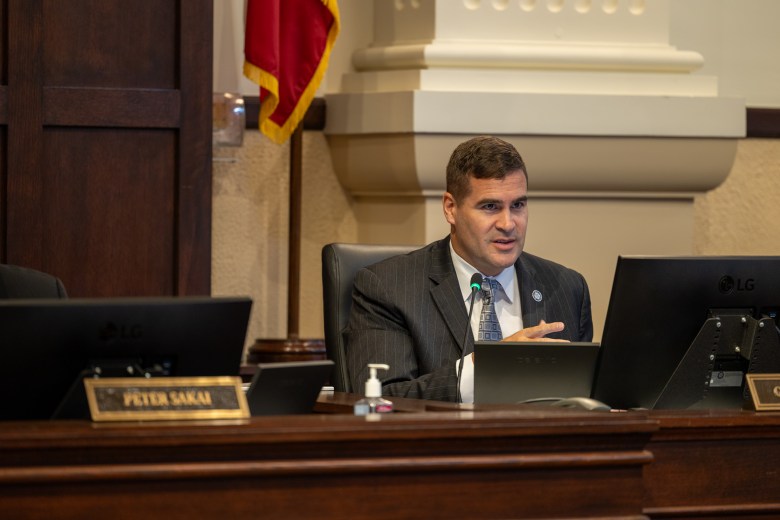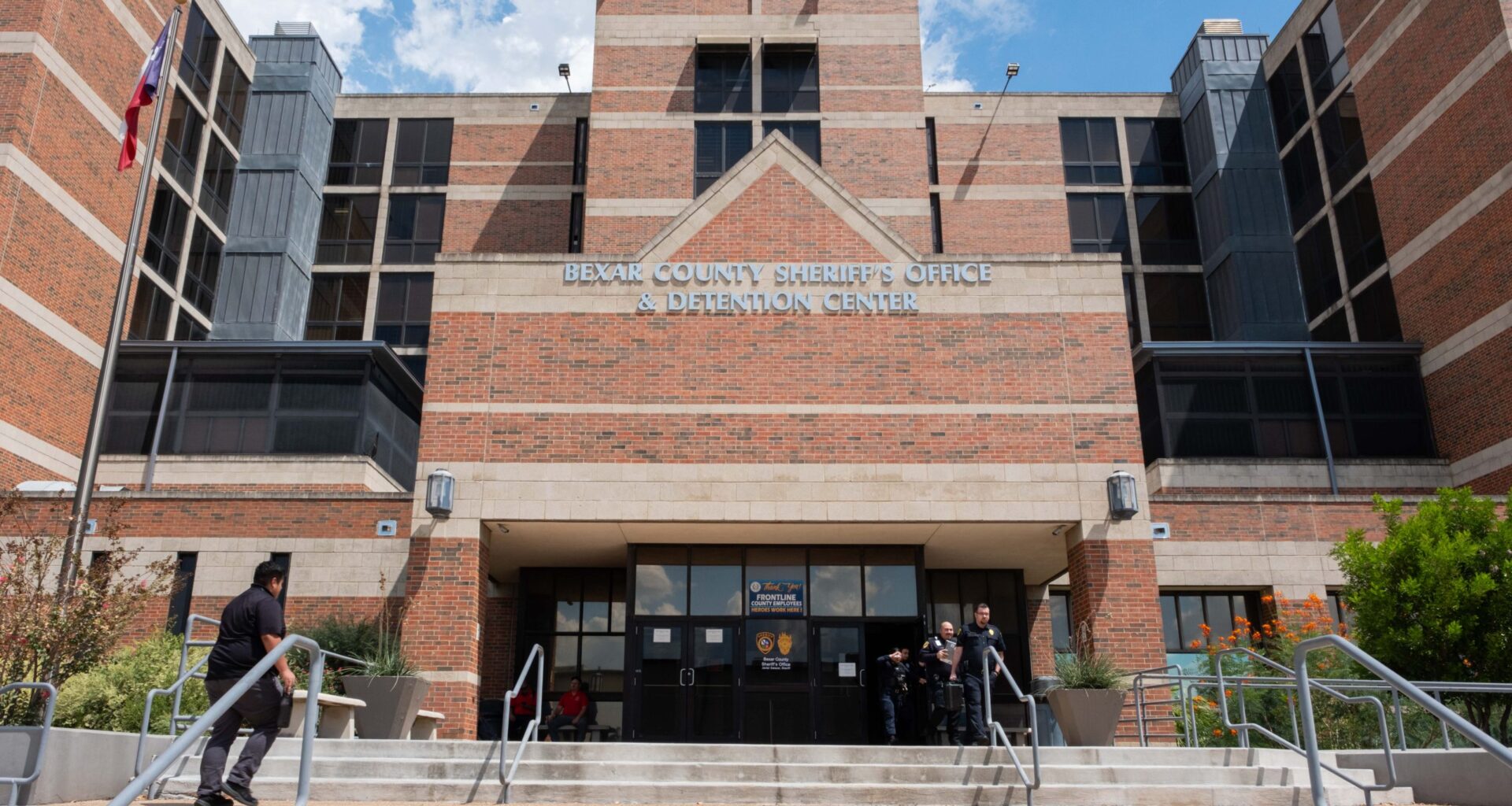Bexar County continues to send inmates to jails in nearby counties — a practice Sheriff Javier Salazar says will remain necessary to meet state jail standards. County Commissioner Grant Moody calls it “an additional cost on top of the costs of running the jail,” as it moves more than $4 million in taxpayer money out of the county each year.
In July 2024, Bexar County began transferring inmates to other county jails to ease pressure on a facility that, the month prior, was just 51 inmates shy of capacity. At the time, Salazar said the practice would become “the new normal” as his office and county commissioners worked to finalize contracts with Burnet and Kerr counties.
County data shows that as of Sept. 26, 252 Bexar County inmates were housed outside the jail — 182 in Burnet County and 70 in Kerr County. All were what’s known as “paper-ready” or inmates who have completed the court process and are awaiting pick up by the Texas Department of Criminal Justice to serve out their sentences.
State law provides a maximum of a 45-day window for pickup and transport to TDCJ facilities from counties after an inmate becomes paper-ready. Until they’re transferred, those inmates remain the county’s financial and logistical responsibility.
“They get basically 45 days of free rent from Bexar County. It’s more cost effective for them to wait as long as they can within that 45 days,” Salazar said. “Knowing that we’re going to have to incur the cost, we do what we have to do as far as jail standards, and we have to house them out of county at that point.”
That pickup process currently takes an average of 29 days for Bexar County — just one day under the statewide average, according to TDCJ data.
At the county’s daily housing cost of $87.17, a 29-day stay comes to roughly $2,527 per inmate. Sending an inmate to Kerr or Burnet counties at rates of $65 and $80 per day, respectively, reduces that cost to between $1,885 and $2,320. Those day rates include fixed expenses such as staffing costs, facility maintenance and upkeep as well as food and medical care for the inmates.
Even with lower daily rates in other counties, the savings are largely offset by fixed expenses Bexar County continues to pay to operate its own jail.
“I can’t speak to all the specifics about how that $87 was calculated, but by shipping off another 300 inmates, we’re not going to reduce our salary costs significantly at the jail or be able to reduce many of those costs that are going into that number. So the reality is those costs are going to be there regardless,” Moody said. “With the jail, near capacity anyway. There’s really no cost savings that can come with that. So it’s just additional costs on top of our costs of running the jail.”
Salazar said the decision to send inmates to other counties ultimately comes down to compliance with state jail standards — even if it means sending taxpayer money elsewhere.
“That money going to other counties helps them pay their bills, I would not dispute that,” Salazar said. “But with that being said, I can’t, just for the sake of not sending money to another county, say, ‘You know what? Let’s just continue to house and then we’ll be out of compliance with jail standards.’ Something’s got to give and in this instance, that’s the lesser of two evils.”
Maintaining compliance, he said, means the jail must remain below its maximum capacity. The Texas Commission on Jail Standards also requires one jailer for each floor of the facility where 10 or more inmates are housed, with no fewer than one jailer per 48 inmates.
The county formally built the practice of sending out its inmates into its annual budget last year, adopting $4.2 million in funding for fiscal year 2024–25 “due to space and staffing issues.”
That figure rose to $4.5 million in the fiscal 2025–26 budget approved earlier this year to “allow the Sheriff’s Office to send out inmates when the jail is at capacity.”
Moody said that amount likely underestimates the cost.
 Bexar County Precinct 3 Commissioner Grant Moody speaks during a county budget work session on Tuesday, Aug. 26. Credit: Diego Medel / San Antonio Report
Bexar County Precinct 3 Commissioner Grant Moody speaks during a county budget work session on Tuesday, Aug. 26. Credit: Diego Medel / San Antonio Report
“I disagreed with the estimate of $4.5 million, and I shared the math publicly in court,” he said. “ We allocated 4.5 million, but as I said in court, you do the math on our current run rate, and it’s more like $7 million per year that we will spend.”
With that funding already built into the county’s budget, Salazar said the decision to continue housing inmates elsewhere will remain driven by population management and space limits at the jail.
“We don’t have the room to keep them in house. Obviously keeping them here is ideal, but we don’t have the room to do it if we want to maintain jail standards,” he said. “You can only have so many people in this facility, and when we’re already at that number, then obviously at that point we’ve got to house people out.”
But state data show Bexar’s jail hasn’t been at capacity in recent months. According to TCJS population reports, the jail operated between 91% and 93% of capacity from July through September, with a rated capacity of 5,108 inmates.
As of the most recent reporting period, the county housed 4,673 inmates — leaving space for roughly 400 more — while still paying to house 266 elsewhere.
Moody said he thinks inmates should remain in Bexar County if space permits but acknowledged that additional operational factors may sometimes limit capacity.
“There are a lot of renovations and maintenance projects that go on in the jail, and sometimes there’s a need for additional space to complete those repairs,” he said. “I can’t speak to anything specifically, but that could be a driver for keeping some additional capacity. But from my vantage point on Commissioners Court, and from a budgetary standpoint, if we have space in the jail, let’s utilize that space first before we pay to send inmates to surrounding counties.”
The sheriff said population trends fluctuate throughout the year but added that recent declines could allow the county to bring some inmates back.
“We’ve got to get that population down,” he said. “Right now, it looks like it’s starting to trend down a little bit. Around this time of year, it usually does. If those numbers hold, then absolutely, it makes more sense to bring some of those people back under our roof.”
Moody questioned the framing of the issue through the lens of state delays in inmate pickups, saying it risks distracting from long-standing capacity challenges at the jail.
“I think that the people are deflecting from our own, you know, mismanagement on the issue and trying to put that on the state, but the state has always done that pick up in that 30 to 45 day window, and they have their own challenges,” He said.” Ultimately, I think it kind of distracts from the key issue of us managing our jail capacity, and making sure we have the space we need, and that the DA is prosecuting cases in a timely manner, so we don’t have 1,700 inmates sitting in our jail, awaiting indictment.”
Moody reiterated that the practice should remain a “stop-gap” short-term solution while Commissioners Court works toward a long-term plan to address capacity.
“I’ve been solution agnostic in all of this. I’m just saying clearly there’s a problem and there’s an issue here that is a county responsibility, and we should be stepping up and addressing it,” he said. “I’ve been talking about this for nearly a year now, and we haven’t really put any mid- to long-term solutions on the table. And so as it stands today, I guess we’re going to continue to ship hundreds of inmates to surrounding counties and spend millions of dollars doing it.”
While Moody said the county must find a sustainable fix, Salazar said the reality is that outsourcing may remain necessary for the foreseeable future.
“I don’t want to say that this is the new normal — I’m afraid that it could be, but I don’t want it to be,” Salazar said.
